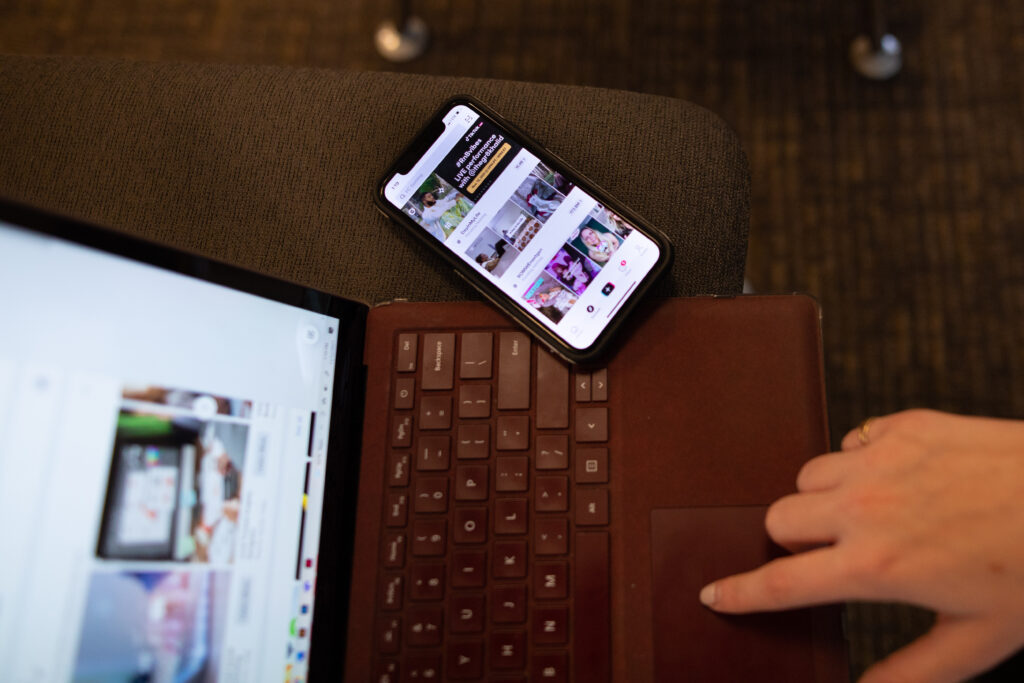Necks hunched over a cellular device of choice, faces illuminated by the hazy glow of Instagram and the distant clicking keyboard sounds of someone passionately Tweeting their latest opinion. This is familiar; this is our reality like never before.
To say that social media has a chokehold on society may be an understatement. It has captivated the minds of each generation in its own way, bringing about unforeseen benefits and disadvantages, but constantly evolving to meet the ever-growing demands of its audience. But how will this phenomenon continue to evolve, and what does the future of social media hold?

Megan Dobson is a University of Idaho microbiology student and director of public relations for the Associated Students of University of Idaho. A typical day for Dobson involves being the liaison between ASUI and the student body, whatever that may entail. She manages the ASUI social media, creating infographics, mainly for Instagram and Facebook, to inform students about campus events and resources. She creates posting schedules, responds to student questions and develops new ways to reach the student audience more efficiently through social media.
With the amount of time she spends on media platforms and her extensive knowledge of social media as a communication tool, Dobson already sees a growing change in social media culture.
While social media has facilitated a platform for the public to engage with their favorite celebrities, it has inadvertently created a new kind of celebrity.
“We’re seeing this weird hybrid where people are gaining fame to from social media,” Dobson said. “They’re just social media famous, they’re ‘influencers.’ It’s interesting because people already compare themselves to traditional mainstream celebrities, but now there are these influencers who have a lot more in common with you than these celebrities ever did, and it can make it way easier to compare yourself.”

Dobson has also noticed social media becoming more of a staple in social justice movements and influencing political change. She cites the 2020 Black Lives Matter movement as a turning point for this.
“I don’t think you could go on a social media platform without being exposed to some kind of information about it,” Dobson said. “Whether that’s performative activism or not depends on the follow-through of each individual, but to me it exposed me to a ton of resources that I’d never seen, and it gave me a lot more information.”
Social media has not only evolved into a way for individuals to connect, but it has also become a crucial tool for brands as businesses to grow their consumer following. John Barnhart is the senior director of Marketing and Creative Services at UI, where he oversees the production of the marketing team, including its social media management. He sees social media as a necessary tool for brands to have a more direct connection to their audience and learn the demographics in which to accommodate to.
“From a university perspective, our audience, whether it’s high school students all the way through alumni, they connect with us using those social channels,” Barnhart said. “What makes social media such a great way to connect is it’s so immediate. An example is our alumni magazine here. It’s beautiful, , but those stories are really a recap of the last six months, where what we put through our social channel is immediate. It happened six seconds ago, not six months ago.”
Holli Sampson is the content marketing strategy manager for Vandal Story Machine at UI and is very familiar with social media development and management. She has seen social media evolve into a branding tool as well as a place of creativity and innovation.
“It’s really as wide open as your imagination,” she said. “I’ve seen businesses lean into almost a personalized shopping experience. I’ve seen schools lean into storytelling. I’ve seen interesting product placement with beautiful photos. I think they have an opportunity to pay a little bit more attention to their marketing strategies and to do more work inside their existing business plan.”
For better or worse, social media will inevitably continue to evolve, whether that be in terms of privacy changes, new features or adapting to the boundaries the public is continuing to set on their social media consumption.

Barnhart predicts a new wave of privacy updates, similar to the recent change in Apple privacy settings.
“What you’ve seen in the last six months with what Apple is doing is just going to continue,” he said. “What you’ll see from a social media perspective is the people that have the first party data are the people that are going to win. It’s the first party data that’s going to be so critical to the success of brands, as they try to market what they do and align that marketing with what they need. The people that hold that information are the ones that are really going to control what the next digital phase looks like.”
Dobson optimistically looks toward the future of healthy, productive social media consumption, and the progress of communication.

“I hope we reach a point where we as social media consumers as individuals, have gained enough digital literacy that we’re able to put up healthy boundaries between our digital lives and our real lives,” she said. “I hope we are cognizant of how we interact with this tool and are also using it like the platform that we’ve always dreamed of having, and we’re using it to share things, communicate things we are passionate about, connect with people and make progress.”
Sampson puts her faith in the early adapters to lead the way; those who are innovative and create new and enhanced features will continue to succeed.
“Media uses their data to refine features,” she said. “Once all the features are out there and people start seeing other people use them, then they’re widely adopted. I don’t see that stopping. I hope businesses don’t waste time in tactics that won’t produce for them.”